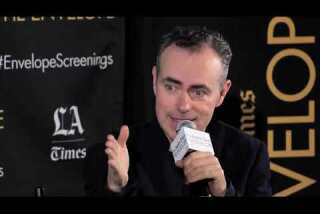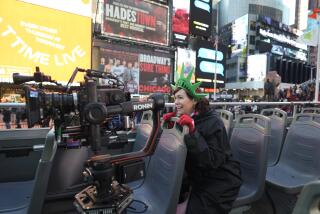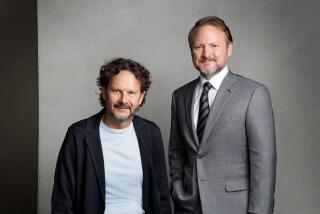With indie films such as ‘Brooklyn’ and ‘Room,’ the creativity often begins with the financing
“Brooklyn” cost $11 million. “Room” had a $13-million budget. Not astronomical amounts for movies that have emerged as crowd-pleasing Oscar contenders, but substantial enough to necessitate some creative financing.
“People are more comfortable giving you very little money or way too much money,” “Brooklyn” director John Crowley says. “That sweet spot of what used to be adult, character-driven movies is a rare beast these days.”
Both “Room” and “Brooklyn” wound up piecing together their financing in much the same manner, procuring the money through a patchwork of film agreements that, as David Kosse, director of Film4, the movie arm of British broadcaster Channel 4, puts it, “have to all close on a given day or it doesn’t work.”
Watch Q&As with ‘Room’s’ Brie Larson


'Room:' When Brie Larson read the novel for the first time

'Room:' Tapping into dark moments with Lenny Abrahamson

'Room:' Breaking down the film's reunion scene

'Room:' Learning from real life victims

'Room:' How everything in the film tells a story
SIGN UP for the free Indie Focus movies newsletter >>
“Room” director Lenny Abrahamson read the Emma Donoghue novel about a captive mother and son and knew he wanted to make it into a movie. He wrote Donoghue a letter, an “impassioned one,” remembers Rena Ronson, head of Independent Film Group at UTA, which set up the financing structure and also represents the author.
It was a case of perfect alignment. Donoghue has dual citizenship in Canada and Ireland. Abrahamson and his producer, Ed Guiney, who runs Element Pictures with Andrew Lowe, are Irish. That combination allowed “Room” to solicit funds from both countries, giving Donoghue the ability to adapt her own book and Abrahamson the freedom to make the film without studio interference. “If you commit to a studio before it’s clear what the film is, you can often find as you develop it that you’re at odds with the people financing it,” Guiney says. “So many films stumble for that reason. They get to a certain point and there’s a standoff. So, if you can, you want to build a little cocoon around the scripting process. You get it in shape and then you go out, not asking for permission. You’re saying, ‘This is what we want to do. Would you like to join us?’”
The period romance “Brooklyn,” which used British, Irish and Canadian tax credits, did the same thing. Producer Finola Dwyer secured $8million of the movie’s $11-million budget in “soft money,” a medley of international co-production treaties. Taking that money meant the film had to re-create its period title setting in Montreal. It also required Crowley to hire a number of Canadian-born production heads, in this case cinematographer Yves Bélanger and art director François Séguin.
For filmmakers who lean on trusted collaborators to navigate tight schedules, those strictly enforced requirements of hiring new faces could pose a challenge. “Brooklyn” shot 35 days over eight weeks in three far-flung locales — Montreal, Ireland and, for two days, Brooklyn. But Crowley believes that being pushed out of his comfort zone helped the movie.
“These guys,” referring to Bélanger and Séguin, “came to Ireland with outside eyes,” he says. “As an Irish filmmaker, I’m painfully aware that portraying 1950s Ireland can quickly lapse into cliche. It was nice to work with people with no preconceived ideas. Sometimes you’re painted in a tight corner but that’s the place you find inspiration.”
Watch Q&As with the ‘Brooklyn’ cast and crew


Video: 'Brooklyn': John Crowley and Saoirse Ronan examine the film's subtle dramatic moments

Video: 'Brooklyn': How the film never tips it's hand

Video: 'Brooklyn': Ireland-born Saoirse Ronan on being Irish for the first time on-screen

Video: 'Brooklyn': John Crowley and Saoirse Ronan explain the film's final boat scene

Video: 'Brooklyn': What it took to capture the Irish spirit
One tight spot Crowley negotiated came on a long May day last year filming outside a Brooklyn brownstone. He started shooting midday and finished at 2 the next morning with the street covered in rapidly melting, manufactured snow.
“We went through spring, autumn and winter with [actress] Saoirse [Ronan] coming and going, changing costumes,” Crowley says. “One day on that street gave us a huge amount of production value.”
Zeroing in on the essentials allowed the film to spend a bit more freely in other areas. It’s the only way these movies get made, says Element Pictures’ Lowe.
“When you’re cobbling together a low-budget film, you’re trying to get enough weeks and money to get something up on screen,” Lowe says. “You’re also trying to give the filmmakers the freedom to realize their vision and create something special. To do that, in most cases, takes its own kind of creativity.”
More to Read
The biggest entertainment stories
Get our big stories about Hollywood, film, television, music, arts, culture and more right in your inbox as soon as they publish.
You may occasionally receive promotional content from the Los Angeles Times.











